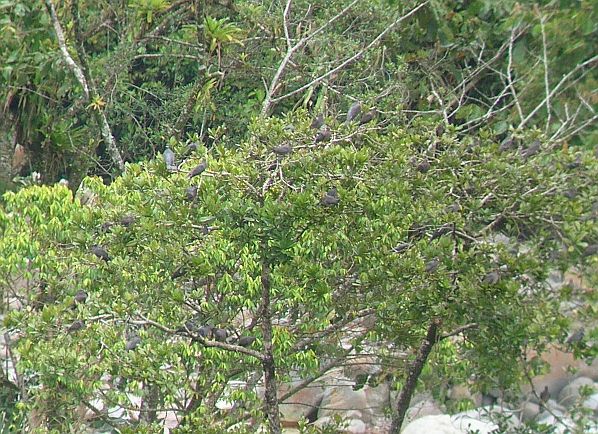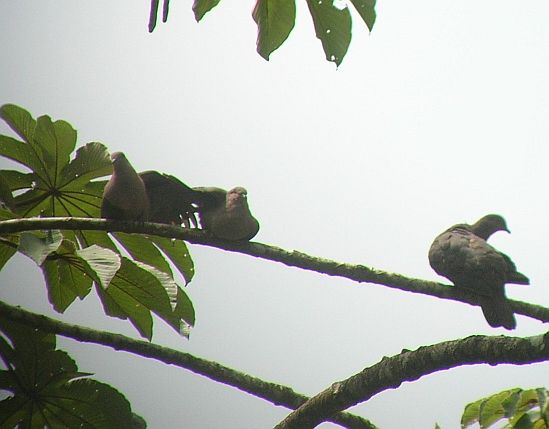I had the fortune of birding Quebrada Gonzalez for two consecutive Saturdays after a three or four month hiatus.
The entrance to Quebrada Gonzalez.
It was good to be back, especially so because it wasn’t pouring down monstrous sheets of rain. Yes, the area does get its fair share of precipitation. The heavy load of epiphytes and moss growing on everything from metal railings to understory leaves hints at the 6 or meters (18 feet) of rain that soaks the area on an annual basis. What’s even crazier is that locals claim that the northern Caribbean lowlands and foothills used to be deluged with even more falling water in the past.
Therefore, I always appreciate sunny weather at Quebrada Gonzalez despite the fact that it tends to make the forest quieter than the steps of a dormouse ninja. While I relish the fact that my umbrella (a poncho is too hot) can remain rolled up and tucked out of sight in my day pack, I wonder why the darn birds can’t also enjoy the absence of rain by becoming more active. Maybe they’re sun bathing up in the canopy? Whatever the antbirds, tanagers, toucans, and trogons are up to, they sure don’t shake the foliage and sing to their hearts content like they do on cloudy days.
So things were pretty quiet on Saturday but as with every visit to Quebrada Gonzalez, we still saw birds, including several species that are tough to see elsewhere in Costa Rica. One of our best sightings was Dull-mantled Antbird. This ravine-inhabiting, understory bird is regular at Quebrada (and at most Caribbean slope foothill sites) but it’s always a pleasure to watch them sing and show off the white patch on their backs.
Where we saw the Dull-mantled Antbirds.
Other bird species from the morning included a Sulphur-rumped Flycatcher flitting around the undergrowth, Emerald and Black and Yellow Tanagers feeding on berries in the subcanopy, and Buff-rumped Warblers hanging out on the trails.
A blurry, Buff-rumped Warbler that was foraging in the parking lot on different, rainy day.
With the hope that the sunny weather would encourage raptors such as Barred Hawk and hawk-eagles to show themselves, we made our way back to the parking lot by 10 am.
Where we watched the skies for raptors.
It took awhile for anything to show itself but eventually we were rewarded with 2 King Vultures. We also saw the other two commonly occurring vultures but no other raptors whatsoever! This was rather surprising to me because I usually see one or two other species of soaring raptor from the parking lot on every visit. Did they take to the air earlier than expected? Were they pretending to be antbirds? We will never know but I suspect it had more to do with the fact that one of our group was hoping to see his first hawk-eagle. No doubt, all three hawk-eagles showed up on Sunday or as soon as we left the area.
Still hoping for soaring raptors, we took the trail on the other side of the road to an overlook with a broad view of a forested ridge. We watched and watched and heard some Dusky-faced Tanagers in the nearby undergrowth and scoped a nearby Broad-billed Motmot but saw nary a vulture! Out on a river island, however, we noticed over 100 Band-tailed Pigeons hanging out in the crowns of a few trees!
The gray things are distant Band-tailed Pigeons.
I have seen these elevational migrants on several occasions at Quebrada Gonzalez but never at this time of year and never in such large numbers. This sort of unpredictable occurrence is one of the reasons why I always love birding at this site- no matter how often I visit, I never really know what I am going to see. There are several species that I encounter on a regular basis but the vagaries of fruiting trees and other not so obvious factors that influence bird distribution in tropical forests always keeps me wondering what will turn up as I walk down the trail.
The trail of surprises.
The solitaires and White-crowned Manakins of the previous week had mostly returned upslope to their usual middle elevation haunts but we still managed to get looks at one female White-crowned Manakin. Hyperactivity on the manakin’s part conspired with vines and leaves to keep us from getting a clear look at her head (and thus identifying her) but perseverance eventually paid off with prolonged views of two diagnostic field marks- a mostly gray noggin and reddish eyes.
Around this time, the vocalizations of one or two Bicolored Antbirds had nearly convinced me that an antswarm was in the works but neither ants nor antbirds showed themselves. However, at least some of us got looks at a Black-headed Nightingale-Thrush and Pale-vented Thrush before we headed back to the parking area for lunch.
We watched the antics of these three Short-billed Pigeons during lunch.
In the afternoon, back into the forest we went and a mere ten minutes later I heard the telltale signs of a mixed flock as a White-throated Shrike-Tanager called. We barely had time to prepare ourselves before we were overrun by a horde of small birds that flitted, crept, and hopped through the surrounding vegetation. As is typical of mixed flocks at Quebrada, Olive (now Carmiol’s) Tanagers were the most abundant member of the flock and their chunky, green forms manifested again and again in our binoculars. Other birds showed up too including Emerald Tanagers, Ashy-throated Bush-Tanager, Russet Antshrike, a sneaky Plain Xenops that refused to give an encore, Wedge-billed Woodcreepers, Streak-crowned Antvireo, Red-eyed Vireo, and the flock leader, a nice oriole-like White-throated Shrike-Tanager.
Aside from a beautiful, male White-ruffed Manakin that briefly displayed on a mossy log, that mixed flock was our last hurrah for birding on Saturday before the rains came back to push us out of the forest.
Back out in the parking lot, I met the new manager of the station, Rodolfo Tenorio. Jovial, upbeat, and friendly, Rodolfo seemed eager to support birding at the site. We will probably set up a sightings log so visiting birders will know where Bare-necked Umbrellabirds have been seen, where antswarms have terrorized communities of arthropods, or where the Tiny Hawk has been perching. He also wanted me to get the word out about rules for visiting the place before 8am:
Although the station doesn’t officially open until 8am, birders can enter as early as they want as long as they let him know in advance. He asks to be contacted at rtenorio45@hotmail.com or and can also be reached at 8823-7678.
Since he can’t check his email on a daily basis, make sure to email him at least a week before your visit to tell Rodolfo the date and time of your visit.
This is excellent news because it leaves open the possibility of looking for owls at the station-something I will certainly be doing sometime soon!








2 replies on “Updates on birding at the Quebrada Gonzalez ranger station, Costa Rica”
Thanks for the amazing trip around Quebrada Gonzalez ranger station! I don’t know if I have stated this on your blog before or not but Costa Rica will be my first birding destination of the neo-tropics. I am very much looking forward to birding there.
With over 850 species to see, what’s not to like?
It’s a good place for a first trip to the neotropics not to mention also being a pretty good place to be for a birder. We will have to get together for birding when you come on down to the land of Snowcaps, Quetzals, and gallo pinto (the Tico version of rice and beans).